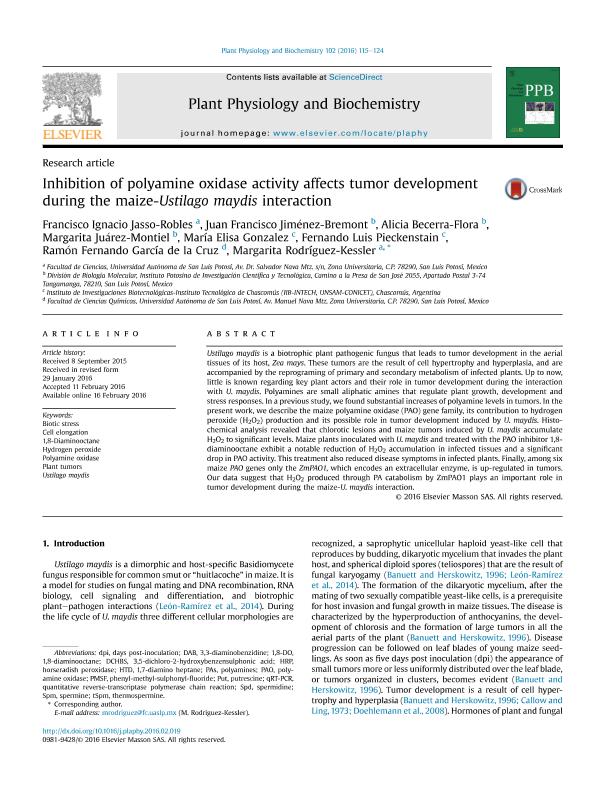Mostrar el registro sencillo del ítem
dc.contributor.author
Jasso Robles, Francisco Ignacio
dc.contributor.author
Jiménez Bremont, Juan Francisco
dc.contributor.author
Becerra Flora, Alicia
dc.contributor.author
Juárez Montiel, Margarita
dc.contributor.author
Gonzalez, Maria Elisa

dc.contributor.author
Pieckenstain, Fernando Luis

dc.contributor.author
García de la Cruz, Ramón Fernando
dc.contributor.author
Rodríguez Kessler, Margarita
dc.date.available
2018-08-09T19:55:32Z
dc.date.issued
2016-05
dc.identifier.citation
Jasso Robles, Francisco Ignacio; Jiménez Bremont, Juan Francisco; Becerra Flora, Alicia; Juárez Montiel, Margarita; Gonzalez, Maria Elisa; et al.; Inhibition of polyamine oxidase activity affects tumor development during the maize-Ustilago maydis interaction; Elsevier France-editions Scientifiques Medicales Elsevier; Plant Physiology and Biochemistry; 102; 5-2016; 115-124
dc.identifier.issn
0981-9428
dc.identifier.uri
http://hdl.handle.net/11336/54853
dc.description.abstract
Ustilago maydis is a biotrophic plant pathogenic fungus that leads to tumor development in the aerial tissues of its host, Zea mays. These tumors are the result of cell hypertrophy and hyperplasia, and are accompanied by the reprograming of primary and secondary metabolism of infected plants. Up to now, little is known regarding key plant actors and their role in tumor development during the interaction with U. maydis. Polyamines are small aliphatic amines that regulate plant growth, development and stress responses. In a previous study, we found substantial increases of polyamine levels in tumors. In the present work, we describe the maize polyamine oxidase (PAO) gene family, its contribution to hydrogen peroxide (H2O2) production and its possible role in tumor development induced by U. maydis. Histochemical analysis revealed that chlorotic lesions and maize tumors induced by U. maydis accumulate H2O2 to significant levels. Maize plants inoculated with U. maydis and treated with the PAO inhibitor 1,8-diaminooctane exhibit a notable reduction of H2O2 accumulation in infected tissues and a significant drop in PAO activity. This treatment also reduced disease symptoms in infected plants. Finally, among six maize PAO genes only the ZmPAO1, which encodes an extracellular enzyme, is up-regulated in tumors. Our data suggest that H2O2 produced through PA catabolism by ZmPAO1 plays an important role in tumor development during the maize-U. maydis interaction.
dc.format
application/pdf
dc.language.iso
eng
dc.publisher
Elsevier France-editions Scientifiques Medicales Elsevier

dc.rights
info:eu-repo/semantics/openAccess
dc.rights.uri
https://creativecommons.org/licenses/by-nc-sa/2.5/ar/
dc.subject
1,8-Diaminooctane
dc.subject
Biotic Stress
dc.subject
Cell Elongation
dc.subject
Hydrogen Peroxide
dc.subject
Plant Tumors
dc.subject
Polyamine Oxidase
dc.subject
Ustilago Maydis
dc.subject.classification
Otras Ciencias Biológicas

dc.subject.classification
Ciencias Biológicas

dc.subject.classification
CIENCIAS NATURALES Y EXACTAS

dc.title
Inhibition of polyamine oxidase activity affects tumor development during the maize-Ustilago maydis interaction
dc.type
info:eu-repo/semantics/article
dc.type
info:ar-repo/semantics/artículo
dc.type
info:eu-repo/semantics/publishedVersion
dc.date.updated
2018-08-03T14:17:46Z
dc.journal.volume
102
dc.journal.pagination
115-124
dc.journal.pais
Francia

dc.journal.ciudad
París
dc.description.fil
Fil: Jasso Robles, Francisco Ignacio. Universidad Autónoma de San Luis Potosí. Facultad de Ciencias; México
dc.description.fil
Fil: Jiménez Bremont, Juan Francisco. Instituto Potosino de Investigación Científica y Tecnológica; México
dc.description.fil
Fil: Becerra Flora, Alicia. Instituto Potosino de Investigación Científica y Tecnológica; México
dc.description.fil
Fil: Juárez Montiel, Margarita. Instituto Potosino de Investigación Científica y Tecnológica; México
dc.description.fil
Fil: Gonzalez, Maria Elisa. Consejo Nacional de Investigaciones Científicas y Técnicas. Centro Científico Tecnológico Conicet - La Plata. Instituto de Investigaciones Biotecnológicas. Instituto de Investigaciones Biotecnológicas "Dr. Raúl Alfonsín" (sede Chascomús). Universidad Nacional de San Martín. Instituto de Investigaciones Biotecnológicas. Instituto de Investigaciones Biotecnológicas "Dr. Raúl Alfonsín" (sede Chascomús); Argentina
dc.description.fil
Fil: Pieckenstain, Fernando Luis. Consejo Nacional de Investigaciones Científicas y Técnicas. Centro Científico Tecnológico Conicet - La Plata. Instituto de Investigaciones Biotecnológicas. Instituto de Investigaciones Biotecnológicas "Dr. Raúl Alfonsín" (sede Chascomús). Universidad Nacional de San Martín. Instituto de Investigaciones Biotecnológicas. Instituto de Investigaciones Biotecnológicas "Dr. Raúl Alfonsín" (sede Chascomús); Argentina
dc.description.fil
Fil: García de la Cruz, Ramón Fernando. Universidad Autónoma de San Luis Potosí. Facultad de Ciencias Químicas; México
dc.description.fil
Fil: Rodríguez Kessler, Margarita. Universidad Autónoma de San Luis Potosí. Facultad de Ciencias; México
dc.journal.title
Plant Physiology and Biochemistry

dc.relation.alternativeid
info:eu-repo/semantics/altIdentifier/url/http://www.sciencedirect.com/science/article/pii/S0981942816300444#MMCvFirst
dc.relation.alternativeid
info:eu-repo/semantics/altIdentifier/doi/http://dx.doi.org/10.1016/j.plaphy.2016.02.019
Archivos asociados
